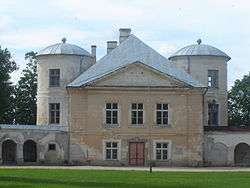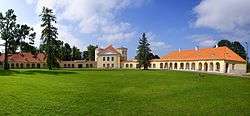Kiltsi Manor
Kiltsi Manor (Estonian: Kiltsi mõis) (also known as Schloß Aß, Schloss Ass, or Gilsenhof) is a knight’s manor in Väike-Maarja Parish, present day Lääne-Viru County, Estonia. It is number 16079 on the Estonian State Register of Cultural Monuments.

.jpg)
.jpg)
History
Kiltsi Manor is first recorded in 1466. It is believed to have been built in the 14th or 15th century in what was then Kiltsi Castle which was destroyed in the Livonian War. In the Middle Ages Kiltsi belonged to the Gilsens, from which it gets its German name Gilsenhof. In the 17th century, Kiltsi was in Asseri parish, and was thus under he ownership of the Uexküll, Zoeged, Mannteuffel, and Rosen families. In 1784 Kiltsi manor was acquired by Major Hermann Johann von Beckendorff, who built a new main house in early classical style (with non-classical turrets) within the manor walls in 1790. From 1816 the manor belonged to famed explorer and scholar Adam Johann von Krusenstern until his death at Kiltsi in 1846. The manor stayed in the Krusenstern family until the early part of the 20th century.
The manor’s last private owner was Alfred von Uexkll-Gyldenband. Since 1920 the manor has been home to a school.
Gallery
 Kiltsi main building with the Benckendorff and Brevern arms.
Kiltsi main building with the Benckendorff and Brevern arms. Kiltsi Manor
Kiltsi Manor The manor seen from the right before the restoration work of 2008–2010
The manor seen from the right before the restoration work of 2008–2010 The manor seen from the left before the restoration work of 2008–2010
The manor seen from the left before the restoration work of 2008–2010 Servants' quarters
Servants' quarters The dairy kitchen
The dairy kitchen Stables
Stables Panorama of the manor
Panorama of the manor Stone bridge in Kiltsi manor park
Stone bridge in Kiltsi manor park
External links
| Wikimedia Commons has media related to Kiltsi manor. |
- Kiltsi Manor, No. 16079 on the State Register of Cultural Monuments
- Commemorative postage stamp
- Kiltsi manor estate portal in Estonia (in Estonian)
- Kiltsi manor at Väike-Maarja Municipality
- Image of Johann Christoph Brotze collection: Plan of "Das Schloß Ass" (in German)
References
- Ants Hein.Kiltsi mõis. Võsupere, VR Kirjastus 2011. (in Estonian)